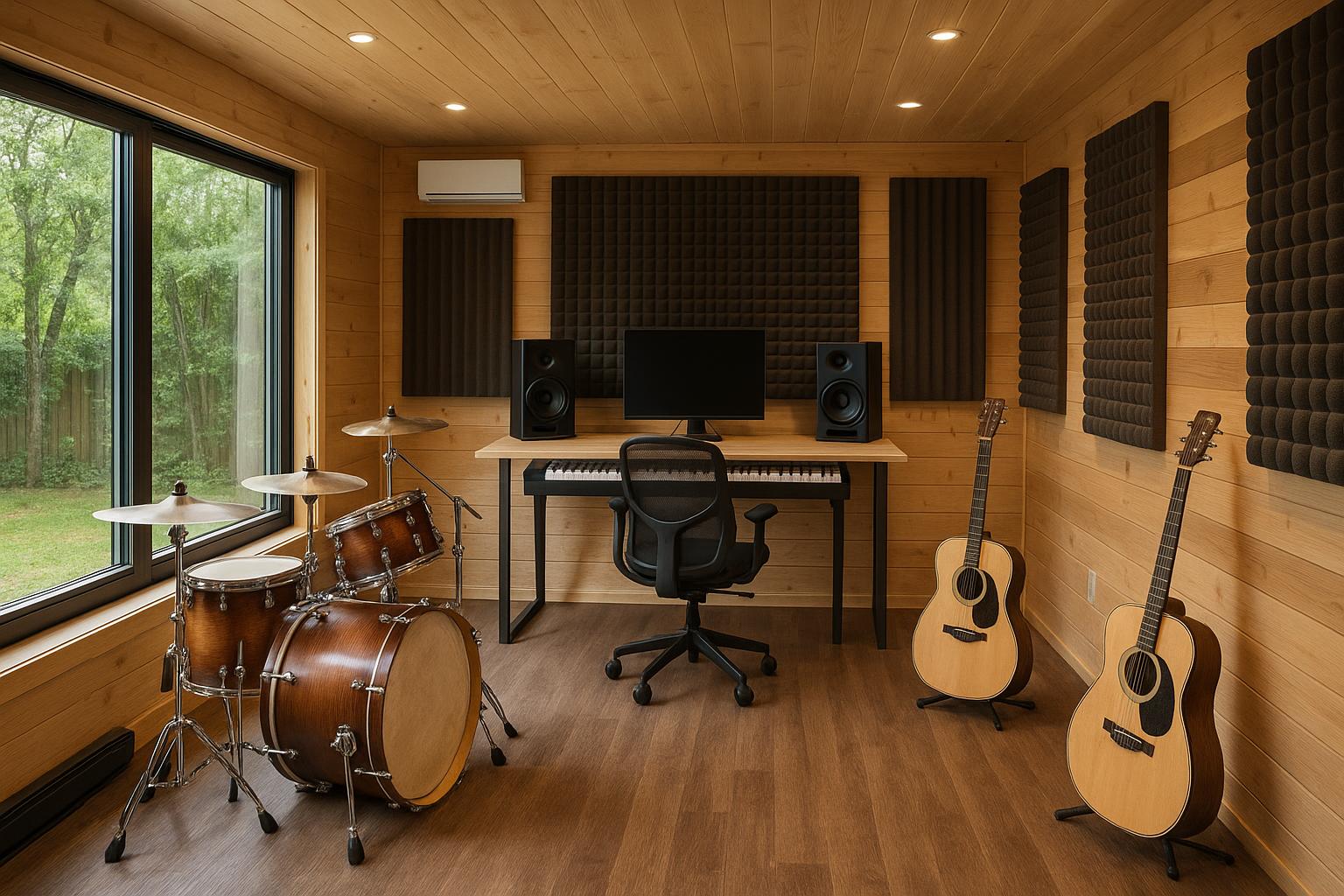
How to Convert an ADU into a Music Studio in Canada: Tips for Design, Soundproofing, and Acoustics
Estimated reading time: 8 minutes
Key Takeaways
- Privacy, Design, and Value: Converting an ADU into a music studio offers a private creative sanctuary while boosting your property’s value.
- Strategic Layouts: Proper space planning, including zoning, room shape optimization, and equipment isolation, ensures optimal functionality.
- Soundproofing vs. Acoustics: While soundproofing blocks external noise, acoustic treatments enhance the clarity and quality of sound within the space.
- Regulatory Compliance: Understanding zoning laws, permits, and building codes across Canadian provinces is critical for a smooth project.
- Expert Guidance: Consulting specialized professionals and using proven resources can streamline design, compliance, and construction.
Table of contents
- Understanding ADUs as Music Studios in Canada
- Design Considerations for an ADU Music Studio in Canada
- Soundproofing Strategies for Canadian ADU Music Studios
- Acoustic Treatments for Optimized Studio Sound
- Regulatory and Permitting Factors in Canada
- Additional Resources and Tips
- Conclusion
- Frequently Asked Questions
Converting an ADU music studio in Canada is a growing trend among musicians and creators. Many artists now realize that having a dedicated music studio—away from the main house—offers not just privacy but a true creative sanctuary. Whether you want a place for late-night recording, mixing tracks, or simply escaping into practice, transforming an Accessory Dwelling Unit (ADU) into a music studio can deeply enhance both your artistic life and property value.
An ADU, also known as a coach house, laneway house, or garden suite, is a small, independent living space on your property. For musicians, it’s the ultimate studio setup: you can design custom layouts, separate your creative process from home distractions, and increase your home’s worth. The potential for tailoring everything—from soundproofing and room shape to equipment storage and gear access—is a game-changer.
In this guide, we’ll break down all the essentials: how to approach design, the best soundproofing strategies, must-have acoustic treatments, and the key regulatory rules Canadian homeowners must follow. By the end, you’ll have a clear roadmap to building a world-class ADU music studio in Canada.
Sources: Studio Shed Music Studios, YouTube Video
Understanding ADUs as Music Studios in Canada
An ADU is a small, separate dwelling—often between 300 and 1,000 square feet—built on a property with an existing main house. Across Canada, these are also known as laneway houses, coach houses, or garden suites. Cities like Vancouver, Toronto, and Ottawa have made ADUs more accessible, not only aiding in urban housing but also attracting musicians.
Why ADUs make fantastic music studios:
- Privacy and Focus: An ADU physically separates your studio from your daily living space, ensuring that late-night sessions don’t disturb your household.
- Noise Management: Soundproofing an ADU is more straightforward—you don’t risk sound leaking into your house, allowing the use of high-performance isolation materials.
- Creative Control: You can choose every detail, from the layout and window placements to the wall angles, creating the ideal environment for sound.
- Multiple Uses Over Time: Today, it’s your studio; tomorrow, it might serve as a guest suite or rental unit, adding long-term value.
Musicians throughout Canada appreciate this approach as it offers a creative “retreat” from everyday life, enabling uninhibited creativity.
For broader property investment benefits and zoning considerations, see our guide on Accessory Dwelling Units: The Ultimate Guide to ADUs for Canadian Property Investment.
Design Considerations for an ADU Music Studio in Canada
Before you pick up a hammer or hang foam panels, a solid design plan is essential. Efficient design distinguishes a fully functional ADU music studio from one that merely looks the part.
Layout and Space Planning for an ADU Music Studio
Organize your ADU’s layout carefully. Not every part of the unit is suitable for recording or mixing. The shape and division of the space have a significant impact on both functionality and acoustics:
- Zone Your Space: Divide the ADU into dedicated areas for recording, mixing, and equipment storage.
- Room Shape: Avoid parallel walls to minimize standing waves and echoes. Asymmetrical designs are ideal.
- Access and Workflow: Position doors and windows so they don’t interfere with your gear or acoustics.
- Storage: Integrate built-in storage to keep microphones, cables, and instruments organized.
These design fundamentals help maximize your space, which is particularly vital in the compact dimensions typical of Canadian ADUs.
If your ADU will serve multiple functions, consider insights from Backyard Cottage: The Practical Canadian Guide to Design, Value, Zoning, DIY Building, and More for versatile design ideas.
Equipment Isolation and Technical Infrastructure in Canadian Music Studios
Noise can ruin a great recording faster than almost anything. Your studio must not only keep external sounds out but also manage noise from your own equipment:
- Isolate Noisy Equipment: Position amplifiers, computers, and rack gear in shielded areas to minimize interference.
- HVAC Planning: Invest in quiet air conditioning and ventilation, and consider running noisy units outside when possible.
- Dedicated Electrical Circuits: Stable and clean power is essential for sensitive recording equipment.
- Lighting: Use dimmable, low-noise LED lighting to avoid disruptive electrical hum and flickering.
Proper equipment integration not only safeguards your recordings but also preserves your investment.
For additional insights on creating a multi-functional workspace, review Creating an ADU Home Office: Innovative Solutions for Productive Remote Work in Canada.
Soundproofing Strategies for Canadian ADU Music Studios
Soundproofing in an ADU Music Studio
Soundproofing is essential for preventing noise from leaking in or out of your studio. In close-knit Canadian neighborhoods, soundproofing is key to both maintaining peace and meeting noise bylaws.
Essential Techniques and Materials
- Mass-Loaded Vinyl Barriers: Install these behind drywall to add a dense layer that blocks sound vibrations.
- Double-Stud Walls: Create a separation between wall frames for improved sound isolation.
- Resilient Channeling: Use metal channels to reduce vibration transfer by decoupling drywall from the studs.
- Acoustic Caulking: Seal every gap to prevent sound leakage through joints and seams.
Top material choices include mineral wool insulation, solid-core doors, triple-glazed windows, and floating floors to block external vibrations.
Always check Canadian municipal and provincial regulations on noise levels to avoid potential fines or neighbor complaints.
Sources: Studio Shed Music Studios, YouTube Video
Dive deeper into soundproofing with our post on Noise Reduction in Canadian Housing: Effective Strategies for Enhancing ADU Comfort and Privacy.
Acoustic Treatments for Optimized Studio Sound
While soundproofing keeps unwanted noise out, acoustic treatment is focused on improving the sound quality within your studio by managing echoes and reverberation.
- Acoustic Panels: Fabric-wrapped panels absorb mid and high frequencies, reducing flutter echo.
- Bass Traps: Thick panels placed in corners absorb low-frequency energy.
- Diffusers: These scatter sound evenly around the room for a balanced acoustic environment.
Customize your treatment based on the studio’s purpose – be it vocal booths for recording or mixing spaces for balanced sound.
For further guidance on interior layouts in small spaces, refer to Small Homes: Compact Living and Efficient Home Design for Stylish and Functional Urban Spaces.
Regulatory and Permitting Factors in Canada for ADUs and Music Studios
Zoning and Permits for Building an ADU in Canada
Regulations for ADU construction vary by city. Key points include:
- Municipal Regulations: Cities such as Vancouver and Toronto have specific rules covering lot sizes, height restrictions, and setbacks.
- Permit Process: Secure approval for both the overall ADU structure and internal modifications especially for soundproofing and electrical upgrades.
- Provincial Differences: Additional codes in provinces like Ontario, BC, Alberta, and Quebec may require extra safety features.
Engage with your local planning department early to understand the requirements.
Source: YouTube Video
For more detailed regulatory guidance, visit Canadian ADU Regulations: A Comprehensive Provincial Guide.
Building Codes and Noise By-Laws for Canadian Music Studios
Canadian building codes, including the National Building Code of Canada (NBCC), set standards for insulation, fire safety, and structural integrity. Additionally, noise by-laws regulate decibel levels during specific hours.
Maintaining thorough documentation of your soundproofing and building specifications is vital, as it may be required during local inspections.
Source: YouTube Video
Further details can be found in our guide ADU Permitting in Ontario: A Comprehensive Guide for Homeowners.
Additional Resources and Tips for Your Canadian ADU Music Studio
Finding Specialized Canadian Contractors and Suppliers
Choosing professionals experienced with ADUs and soundproofing can ensure your project meets all technical and regulatory requirements. Look for experts in ADU construction and soundproofing who can provide testimonials and references.
Source: YouTube Video
For more advice on selecting the right builder, see How to Choose a Reliable Tiny Home Builder Canada: Expert Hiring Advice and Construction Tips for Your Project.
Technology, Equipment, and Budgeting for a Music Studio in Canada
Building an ADU music studio is a significant investment. Budget for core technology like audio interfaces, digital audio workstations, and high-quality speakers, as well as for high-performance soundproofing and acoustics.
It is wise to allocate more funds for soundproofing and acoustic treatments than for additional gadgets to ensure superior sound quality and compliance.
Sources: Studio Shed Music Studios, YouTube Video
For insights on hidden costs, read Understanding Hidden Costs in ADU Construction: A Comprehensive Guide for Canadian Homeowners.
Conclusion: Building Your Ideal ADU Music Studio in Canada
Building an ADU music studio in Canada is a step-by-step journey that results in a private creative retreat, enhanced property value, and a superior environment for musical production.
Remember to:
- Plan Your Design: Tailor your layout and gear placement to suit your creative workflow.
- Invest in Soundproofing: Use proven techniques and materials to protect your recordings and respect your neighbors.
- Optimize Acoustics: Balance absorption and diffusion for clear, accurate sound.
- Understand Regulations: Ensure compliance with local building codes and noise bylaws.
- Collaborate with Experts: Work with specialized professionals to achieve a seamless build process.
Your ADU music studio will not only be a creative haven but also a valuable asset to your property.
Ready to begin? Use this guide as your foundation, connect with experienced Canadian professionals, and utilize the resources provided to bring your musical vision to life.
Additional Resources:
Frequently Asked Questions
Q: What is an ADU?
A: An ADU (Accessory Dwelling Unit) is a small, self-contained living space built on the same lot as a main house. It is often used as a guest suite, rental unit, or, as discussed here, a music studio.
Q: How does soundproofing differ from acoustic treatment?
A: Soundproofing prevents noise from entering or leaving a space, while acoustic treatment improves the internal sound quality by managing echoes and reverberation.
Q: Are there specific Canadian regulations for ADU conversions?
A: Yes, regulations vary by city and province. It is important to check local zoning laws, obtain necessary permits, and adhere to building codes and noise bylaws when converting an ADU into a music studio.
Q: Can I build a multi-functional ADU?
A: Absolutely. Many ADUs are designed for versatility. With careful planning, your ADU can serve as a music studio, guest suite, or home office, adapting to your needs over time.
Q: How do I ensure proper equipment isolation?
A: Work with professionals to design and install dedicated circuits, strategic equipment placement, and acoustically isolated zones that minimize interference and protect your recording quality.

Leave a Reply